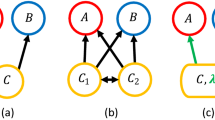Abstract
Ecological communities can lose their permanence if a predator or a competitor is removed: the remaining species no longer coexist. This well-known phenomenon is analysed for some low dimensional examples of Lotka-Volterra type, with special attention paid to the occurrence of heteroclinic cycles.
Similar content being viewed by others
References
Arneodo, A., Coullet, P., Tresser, C.: Occurrence of strange attractors in three dimensional Volterra equations. Physics Letters 79A, 259–263 (1980)
Chenciner, A.: Comportement asymptotique de systèmes differentiels du type ‘competition d'espèces’. Comptes Rendus Acad. Sci. Paris 284, 313–315 (1977)
Cramer, N. F., May, R. M.: Interspecific competition, predation and species diversity: a comment. J. Theor. Biol. 3, 289–293 (1972)
Fujii, K.: Complexity-stability relationship of two-prey one-predator species system model: local and global stability. J. Theor. Biol. 69, 613–623 (1977)
Ginzburg, L. R., Akcakaya, H. R., Kim, J.: Evolution of community structure: competition. J. Theor. Biol. 133, 513–523 (1988)
Hofbauer, J., Sigmund, K.: Permanence for replicator equations. In: Kurzhanski, A., Sigmund, K. (eds.) Dynamical systems. (Lect. Notes Econ. Math. Syst., Vol. 287) Berlin Heidelberg New York: Springer 1987
Hofbauer, J., Sigmund, K.: The theory of evolution and dynamical systems. Cambridge: Cambridge University Press 1988
Hsu, S. B. Predator-mediated coexistence and extinction. Math. Biosci. 54, 231–248 (1981)
Hutson, V., Vickers, G. T.: A criterion for permanent coexistence of species with an application to a two-prey one-predator system. Math. Biosci. 63, 253–269 (1983)
Jansen, W.: A permanence theorem for replicator and Lotka-Volterra systems. J. Math. Biol. 25, 411–422 (1986)
Kirlinger, G.: Permanence in Lotka-Volterra equations: linked predator-prey systems. Math. Biosci. 82, 165–191 (1986)
Kirlinger, G.: Permanence of some ecological systems with several predator and one prey species. J. Math. Biol 26, 217–232 (1988)
May, R. M.: Stability and complexity in model ecosystems. Princeton: Princeton University Press 1973
May, R. M., Leonard, W.: Nonlinear aspects of competition between three species. SIAM J. Appl. Math. 29, 243–252 (1975)
Paine, R. T.: Food web complexity and species diversity. Am. Nat. 100, 65–76 (1966)
Parish, J. D., Saila, S. B.: Interspecific competition, predation, and species diversity. J. Theor. Biol. 27, 207–220 (1970)
Schuster, P., Sigmund, K., Wolff, R.: Cooperative and competitive behaviour of hypercycles. J. Differ. Equations 32, 357–368 (1979)
Svirezhev, Y. M., Logofet, D. O.: Stability of biological communities. Moscow: Mir 1983
Vance, R. R.: Predation and resource partitioning in one predator-two prey model communities. Am. Nat. 112, 797–813 (1978)
Author information
Authors and Affiliations
Rights and permissions
About this article
Cite this article
Hofbauer, J., Sigmund, K. On the stabilizing effect of predators and competitors on ecological communities. J. Math. Biology 27, 537–548 (1989). https://doi.org/10.1007/BF00288433
Received:
Revised:
Issue Date:
DOI: https://doi.org/10.1007/BF00288433




